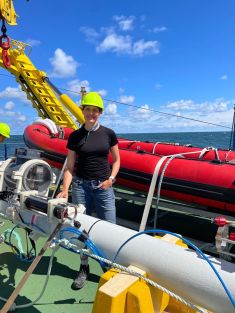
Where the Baltic Sea touches the sky - Air-Sea interaction in the Baltic Sea
01.07 - 07.07.2022 – All about bubbles!
One of the privileges of living at sea is that you live inside the rhythm of the ocean, rolling with the ship as the restless water shifts beneath you. Our metal home is part of the boundary between the atmosphere and the ocean, and the movement is a constant reminder that this boundary is dynamic. It's not just that the surface changes shape as waves roll past, but also that it can shatter and reform when waves break to form thousands of small bubbles. These bubbles are temporary, but together they add significant surface area, in addition to the turbulence generated by the breaking process. The reason that we're here is to understand how gases cross the complex air-sea boundary, and the bubbles are part of that process.
Today we deployed a bubble measurement buoy, so that we can get some idea of how many bubbles are being formed. Measuring ocean bubbles accurately is difficult - the big ones at the surface only last for a few seconds, and the ones that move further downward are very small. It's hard to be in the best place - right at the ocean surface - without the risk of creating your own bubbles as waves slap against a buoy. Here, we're using a specialised bubble camera that was built specifically for this job, along with some dissolved gas sensors to find out how oxygen is moving around in the top few metres of the sea. In the first test, we also had a hydrophone, to listen to new bubbles being formed. But the hydrophone stopped working after the test deployment (there's always a sacrifice at sea!), so the data we'll get back will be pictures only, without any sound. These instruments are all in the water now, drifting with the waves, and the electronics are in control for the next three days. After that, we'll bring it back on board to download data and replace the batteries.
Everyone is relieved that the major parts of the experiments have now started properly. It's been a tough start to the cruise - lots of us had problems with different scientific instruments, and it seemed as though everything was a bit of a struggle. But most of the problem have now been sorted out, and from now on we will have a much more regular schedule. Best of all (for those of us interested in bubbles), the wind will pick up tomorrow, so there will hopefully be plenty of bubbles to measure.
Text:
Helen Czerski (University College London)
Coordination and editorial fine-tuning:
Bita Sabbaghzadeh (IOW) and Josefine Karnatz (GEOMAR)
| Expedition: | EMB295 |
| Mission: | CenBASE |
| Start date: | 30.06.2022 |
| End date: | 19.07.2022 |
